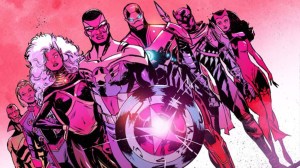As the Marvel Cinematic Universe heads into a new era following the release of Avengers: Endgame this month, one thing is clear: the universe inhabited by the Marvel superheroes on the big screen will never be quite the same again. With some of the actors’ contracts ending and at least one major death expected in the battle to reverse Thanos’s Decimation, there are really only a few things that can happen. They might move on without some of the major characters in the Marvel canon, avoiding telling Iron Man and Captain America stories for the foreseeable future. They might recast and replace at least one such character, setting up a James Bond-style situation where actors can be replaced but the story moves on. They could reboot entirely — although the likelihood of that, given that there have been sequels announced to several of the existing film franchises seems close to zero.
Videos by ComicBook.com
Or, the Marvel Cinematic Universe could take a lesson from DC Comics and embrace the concept of legacy. Given yesterday’s report that a Hawkeye series is coming to Disney+ that centers on Clint Barton training Kate Bishop to be the Hawkeye of the next generation, it seems like this one might be the way Disney decides to go. And while Marvel has had recent success with some legacy characters — especially the Carol Danvers Captain Marvel — it is something that DC has been doing consistently and effectively for more than fifty years. While DC has rarely brought their “legacy heroes” to the screen, their comics — especially those published since Crisis on Infinite Earths — offer a guide to how Marvel might effectively build goodwill with the fans while replacing some of the best-known and best-loved superheroes ever to come to life.
After more than a decade of being the biggest success story in Hollywood, and the struggles Warner Bros. experienced trying to keep up with them, why should Marvel look to DC for guidance? Well, it’s really just a numbers game. While legacy heroes are relatively few and far between at Marvel, they have been a staple of DC’s publishing lineup for years. There was likely a philosophical reason for this as well as practical ones. Stan Lee famously told writers at Marvel to pursue the “illusion of change” — to tell big, important-feeling stories that ultimately reset to the classic status quo. In general, the illusion of change (whether or not it was acknowledged and called that) has always driven comic book storytelling (and serialized storytelling more generally) — but sometimes the illusion is more “real” than others. In DC’s case, there have been heroes who took over the identity of another and became the default in the minds of the audience.
DC has been making legacy heroes work since the Silver Age, when Barry Allen appeared as The Flash with the same power set as Jay Garrick, but a totally different look and origin. Shortly thereafter, the Hal Jordan Green Lantern came around with more or less the same M.O. Since the readership was younger and there were relatively few readers around who had been with DC since the ’30s and ’40s, it was easy enough to imprint on a new generation that Barry and Hal were “the” heroes of those names. In the ’80s and ’90s, a number of mainstream heroes were replaced, seemingly permanently, again — but with a wrinkle: by the time Wally West became The Flash and Kyle Rayner became Green Lantern, the Golden Age heroes had become staples of DC’s publishing line again, interacting with their successors and discussing the importance of heroes who carried on a legacy.
That idea was a driving force behind Geoff Johns’s fan-favorite JSA, which centered on the Justice Society of America as it blended the original members with their children, grandchildren, sidekicks, and more. Ironically, the move to abandon many of the legacy heroes and return to a pre-Crisis on Infinite Earths status quo was also spearheaded by Johns, whose Green Lantern: Rebirth and The Flash: Rebirth miniseries reinstated Hal Jordan and Barry Allen as the leads of those titles. Most legacy heroes have been removed from the “main” role now, or renamed and given a new role and new responsibilities. Still, attempts by DC to abandon the “legacy” model and reinvent the DC Universe as a brand-new world full of young heroes with no backstory failed spectacularly with the fans, and after a few years of The New 52, Johns wrote DC Universe: Rebirth, which reintroduced the post-Crisis Wally West. The larger Rebirth publishing initiative gave DC heroes their histories (and sidekicks, mentors, and so on) back, with a handful of exceptions, some of whom Johns are working to reinstate now in Doomsday Clock).
DC, then, has built up legacy as such an imporant component of their identity that when it was abandoned entirely in their comics, fans revolted. Meanwhile, their live-action adaptations have not built up the long and interconnected history that the MCU has, so while they have some legacies represented onscreen — Dick Grayson and Jason Todd both appear as Robins on Titans, for instance — they are relatively few and far between. Marvel, for their part, seems poised to take on the task of taking the “illusion of change” to the next level and bringing in some quasi-permanent subs, next-gen heroes, and legacy heroes to stand in place of the actors they are losing.
They could do a lot worse than to look at how their competition has been doing it in the comics for the last 50 years.





